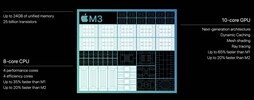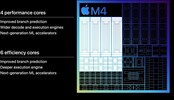Apple M3 vs Apple M4 (10 cores)
Apple M3
► remove from comparison
The Apple M3 is a system on a chip (SoC) from Apple for notebooks that was introduced in late 2023. It integrates a new 8-core CPU with 4 performance cores with up to 4.06 GHz and 4 efficiency cores running at up to 2.75 GHz. Apple claims that the CPU is up to 20% faster than in the old Apple M2 (3.5 GHz).
Due to the higher clock speeds and architecture improvements, the processor performance is also significantly better than the M2 in benchmarks (see e.g. Geekbench below) and can keep up with the fastest CPUs in short single-core tests (like the Raptor Lake i9-13950HX).
The M3 also integrates a new graphics adapter with dynamic caching, mesh shading and ray tracing acceleration called Apple M3 10-Core GPU. According to Apple, it is 20% faster than the GPU in the M2. The chip integrates again 10 GPU cores, but the cheaper variant only offers 8 cores (e.g. in the entry iMac). Later in early 2025 Apple also introduced a 9-core variant in the new iPad Air models. Furthermore, the GPU only supports 2 displays (an additional 6K60 display to the internal one).
Both GPU and CPU can access the unified memory on the package together. It is still available in 8, 16 and 24 GB variants and offers the same 100 GB/s maximum bandwidth (unlike the Pro models that feature a reduced memory bandwidth).
The integrated 16-core Neural Engine has also been revised and now offers 18 TOPS peak performance (versus 15.8 TOPS in the M2 but 35 TOPS in the new A17 Pro). The video engine now supports AV1 decoding in hardware. H.264, HEVC and ProRes (RAW) can still be decoded and encoded.
Unfortunately, the integrated wireless network module only supports Wi-Fi 6E (no Wi-Fi 7) and due to the support of only a single external monitor, the chip also has to make do with no Thunderbolt 4 (Thunderbolt 3 / USB 4 support only for up to 40 Gbit/s).
The chip is manufactured on the current 3nm TSMC process (N3B most likely) and contains 25 billion transistors (+25% vs. Apple M2). The 3nm process should also contribute to the excellent efficiency of the chip. Under load, the M3 CPU consumes approximately 20 Watt.
Apple M4 (10 cores)
► remove from comparison
The 10-core Apple M4 is an impressively fast ARM architecture processor (SoC) sporting 4 performance and 6 efficient CPU cores along with a 16-core neural engine and a 10-core GPU with hardware RT support and other modern features. On-package 7500 MT/s LPDDR5x RAM, USB 4 support and Thunderbolt 4 support are onboard as well, as are Wi-Fi 6E and Bluetooth 5.3.
The M4 debuted in May 2024 as part of an iPad launch event; its 4 performance cores run at up to 4.4 GHz, representing a healthy improvement over the M3 (10-core GPU) and its 4.06 GHz top clock speed. Besides, this new chip also has 6 efficient cores at its disposal that run at up to 2.9 GHz. The M3 had to make do with 4 performance cores and 4 efficient cores, for reference.
Architecture and Features
The new CPU cores run at faster clock speeds than what the M3 was capable of while also featuring some minor architectural improvements. A heavily customized version of ARM's v9.4-A microarchitecture is reportedly employed here. The M4 comes with on-package LPDDR5x-7500 RAM (120 GB/s) whereas the M3 was limited to 6400 MT/s. The updated NPU delivers up to 38 TOPS of performance for AI workloads.
Performance
In 2024 iPad Pros, the 3 nm chip is 10% to 20% faster than the M3 (10 GPU cores) in both multi-thread and single-thread short-term workloads. It also delivers about 10% higher multi-thread performance than the 9-core M4. This puts the 10-core part on an equal footing with the Ryzen 7 7745HX, Core i7-13705H and other higher-end x86 processors released in 2023 and 2024.
iPad Pros come with no active cooling solution however Mac minis and MacBook Pros do have one and the latest iMacs probably do as well. As our Fall 2024 Mac mini review shows, the M4's short-term performance doesn't benefit much from the presence of a fan, however its sustained performance benefits tremendously.
Graphics
The M4 GPU (10 cores) has hardware support for ray tracing as well as mesh shading and other modern technologies. It supports external displays with resolutions as high as 8K.
The graphics adapter runs at higher clock speeds than what the (otherwise identical) 10-core GPU built into the 9-core M4 can muster. As our Mac mini 2024 review confirmed, its performance is good enough to run many 2023 and 2024 games at 1080p on low or medium quality settings.
- Сyberpunk 2077 2.1 Phantom Liberty (1080p, Med): 28 fps
Much like it is with CPU performance, M4-powered iPad Pros will be much slower in long-term GPU-intensive workloads than iMacs, Mac minis and MacBook Pros due to the lack of proper cooling.
Power consumption
This specific M4 chip is found in 2024 iPad Pros, 2024 iMacs, 2024 Mac minis and 2024 MacBook Pros. Within the thin metal cases of the iPads - no active cooling - the chip's sustained power consumption hovers in the 4 W - 5 W area, with short-term peaks of up to 14 W possible. However, Mac minis and MacBook Pros do have an active cooling solution (and the new iMacs probably do, too) meaning the power consumption figures are several times higher. In our Fall 2024 Mac mini review, the SoC consumed 30 W to 40 W when under high loads.
The M4 is built with a "second generation" 3 nm TSMC process which is still cutting-edge as of late 2024.
| Model | Apple M3 | Apple M4 (10 cores) | ||||||||||||||||||||||||||||||||||||||||||||||||
| Series | Apple M3 | Apple M4 | ||||||||||||||||||||||||||||||||||||||||||||||||
| Series: M4 |
|
| ||||||||||||||||||||||||||||||||||||||||||||||||
| Clock | 2748 - 4056 MHz | 2890 - 4464 MHz | ||||||||||||||||||||||||||||||||||||||||||||||||
| L2 Cache | 4 MB | 4 MB | ||||||||||||||||||||||||||||||||||||||||||||||||
| Cores / Threads | 8 / 8 4 x 4.1 GHz Apple M3 P-Core 4 x 2.7 GHz Apple M3 E-Core | 10 / 10 4 x 4.5 GHz Apple M4 P-Core 6 x 2.9 GHz Apple M4 E-Core | ||||||||||||||||||||||||||||||||||||||||||||||||
| Transistors | 25000 Million | 28 Million | ||||||||||||||||||||||||||||||||||||||||||||||||
| Technology | 3 nm | 3 nm | ||||||||||||||||||||||||||||||||||||||||||||||||
| Features | ARMv8 Instruction Set | Unified Memory LPDDR5X-7500 (120 GB/s), 16-Core Neural Engine, Media Engine (Encoding / Decoding: H.264, HEVC, ProRes, ProRes RAW, AV1 Decoding only) | ||||||||||||||||||||||||||||||||||||||||||||||||
| iGPU | Apple M3 10-Core GPU | Apple M4 10-core GPU | ||||||||||||||||||||||||||||||||||||||||||||||||
| NPU / AI | 18 TOPS INT8 | 38 TOPS INT8 | ||||||||||||||||||||||||||||||||||||||||||||||||
| Architecture | ARM | ARM | ||||||||||||||||||||||||||||||||||||||||||||||||
| Announced | ||||||||||||||||||||||||||||||||||||||||||||||||||
| Manufacturer | www.apple.com | |||||||||||||||||||||||||||||||||||||||||||||||||
| TDP | 40 Watt | |||||||||||||||||||||||||||||||||||||||||||||||||
| TDP Turbo PL2 | 40 Watt |
Benchmarks
Average Benchmarks Apple M3 → 100% n=18
Average Benchmarks Apple M4 (10 cores) → 124% n=18
* Smaller numbers mean a higher performance
1 This benchmark is not used for the average calculation





